story and photos by Kayte Deioma
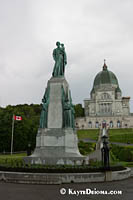 Montreal is a great city for exploring on your own and any of the venues in this issue would be perfectly appropriate to visit alone. But I somehow think of spiritual places as good solo destinations to take a quiet moment and ponder the universe. St. Joseph’s Oratory on Mount Royal is a nice spot for such pondering.
Montreal is a great city for exploring on your own and any of the venues in this issue would be perfectly appropriate to visit alone. But I somehow think of spiritual places as good solo destinations to take a quiet moment and ponder the universe. St. Joseph’s Oratory on Mount Royal is a nice spot for such pondering.
Brother André Bessette became known in his 30s for being able to heal the sick. He attributed this to the intervention of St. Joseph, who has been credited with centuries of miraculous events in Canada. In 1904, Brother André and some friends built a chapel to his patron across the street from Notre Dame College where he was porter. Over a period of 62 years, the current Basilica was built on the site. Brother André died in 1937 before the dome was added. The final interior elements of the Basilica were completed in 1966.
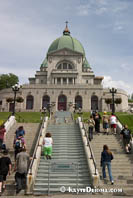 St. Joseph’s Oratory, at 856 feet (263 meters) above sea level, is the highest point in Montreal. From street level to the top of the dome is 506 feet (155 meters). That’s a lot of stairs to climb, especially if you are a pilgrim climbing the stairs on your knees. If you don’t feel like scaling the 233 steps up to the Crypt level, a shuttle will drive you from the gate house at street level up to the entrance.
St. Joseph’s Oratory, at 856 feet (263 meters) above sea level, is the highest point in Montreal. From street level to the top of the dome is 506 feet (155 meters). That’s a lot of stairs to climb, especially if you are a pilgrim climbing the stairs on your knees. If you don’t feel like scaling the 233 steps up to the Crypt level, a shuttle will drive you from the gate house at street level up to the entrance.
To get the most of your visit, pick up an Arrow Guide for $2 (Canadian) at the Information Center or Gift Shop before you start exploring. This 29-page illustrated booklet leads you on a numbered tour through the shrine, making maximum use of available escalators. There is also a map and a free flyer called What to See, a simple list of the numbered features of the Oratory. In the off season, you may have to go to the General Office to get a map, or you can print it out and take it with you.
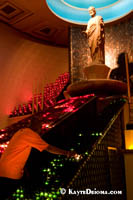 The Arrow Guide suggests entering the building from the side entrance into the Votive Chapel (marked with the number 1), a long corridor lined with votive altars. Each one is a tribute to St. Joseph in his various functions as model for workers, guardian of virgins, support of families, terror of demons, consolation of the afflicted, hope of the sick, patron of the dying, and protector of the Church. Halfway down the hall in the center lamp rack, 3,500 of the chapel’s 10,000 votive candles rise up to a statue of Joseph with arms outstretched. Between the altars, wooden crutches of those healed by Brother André are displayed hanging in rows. Notably, there are no aluminum crutches or other evidence of people being healed since the pious man’s passing.
The Arrow Guide suggests entering the building from the side entrance into the Votive Chapel (marked with the number 1), a long corridor lined with votive altars. Each one is a tribute to St. Joseph in his various functions as model for workers, guardian of virgins, support of families, terror of demons, consolation of the afflicted, hope of the sick, patron of the dying, and protector of the Church. Halfway down the hall in the center lamp rack, 3,500 of the chapel’s 10,000 votive candles rise up to a statue of Joseph with arms outstretched. Between the altars, wooden crutches of those healed by Brother André are displayed hanging in rows. Notably, there are no aluminum crutches or other evidence of people being healed since the pious man’s passing.
On the right, doors on either side of the center lamp rack lead to Brother André’s Tomb. At the far end of the Votive Chapel, blessed oil at the foot of St. Joseph’s statue is said to have healing properties. They bottle it and sell it in the Gift Shop.
 To the left is the Crypt Church, so named for the flattened arches supporting the ceiling and its position at the foot of the Basilica. Rather than the traditional cross over the altar, a nine-foot statue of St. Joseph takes pride of place. The Christ statue on the large crucifix to the right of the altar has worn feet from the hands of many pilgrims. A giant statue of Brother André looms in front of the stained glass windows on the right wall. The colorful panels represent events in the life of St. Joseph.
To the left is the Crypt Church, so named for the flattened arches supporting the ceiling and its position at the foot of the Basilica. Rather than the traditional cross over the altar, a nine-foot statue of St. Joseph takes pride of place. The Christ statue on the large crucifix to the right of the altar has worn feet from the hands of many pilgrims. A giant statue of Brother André looms in front of the stained glass windows on the right wall. The colorful panels represent events in the life of St. Joseph.
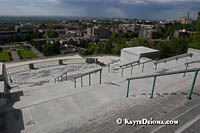 Doors at the back of the Crypt Church will take you to the escalators up to the Concourse Hall where you will find access to the terrace which provides a view of Montreal down the west side of Mount Royal. You’ll also find restrooms and drinking fountains on this floor and the stairway to theBrother André Display. You have to take the stairs, as the escalator bypasses this area. This exhibit contains recreations of the doorkeeper’s lodge at Notre Dame College, Brother André’s office and the hospital room where he died, some of them with original features. However the most important artifact in this display is the reliquary with Brother André’s heart.
Doors at the back of the Crypt Church will take you to the escalators up to the Concourse Hall where you will find access to the terrace which provides a view of Montreal down the west side of Mount Royal. You’ll also find restrooms and drinking fountains on this floor and the stairway to theBrother André Display. You have to take the stairs, as the escalator bypasses this area. This exhibit contains recreations of the doorkeeper’s lodge at Notre Dame College, Brother André’s office and the hospital room where he died, some of them with original features. However the most important artifact in this display is the reliquary with Brother André’s heart.
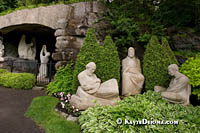 Back down on the Concourse level you can exit to the Way of the Crossand the Oratory Gardens. The larger-than-life Stations of the Cross lead through the gardens to the Pool and Fountain of Redemption. It’s a beautiful place to dwell and contemplate in nice weather, but if it’s raining significantly, you might want to proceed up the escalator to the OratoryMuseum.
Back down on the Concourse level you can exit to the Way of the Crossand the Oratory Gardens. The larger-than-life Stations of the Cross lead through the gardens to the Pool and Fountain of Redemption. It’s a beautiful place to dwell and contemplate in nice weather, but if it’s raining significantly, you might want to proceed up the escalator to the OratoryMuseum.
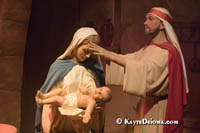 The front galleries are used for rotating exhibits from the Museum’s significant collection of artwork related to the Holy Family, St. Joseph and Brother André. Part of every year includes a Nativity Exhibit with 200 to 300 of the Museum’s thousands of crčches from around the world from the 6 th century through the present. Each annual exhibit includes at least 100 nativity scenes that have not been exhibited before. They range from miniatures to life size, from Indian needlework to Vietnamese Mother of Pearl, Sudanese ebony and incense paste from Singapore. The permanent exhibit at the back of the Museum is a series of wax figures behind glass portraying scenes from the life of St. Joseph.
The front galleries are used for rotating exhibits from the Museum’s significant collection of artwork related to the Holy Family, St. Joseph and Brother André. Part of every year includes a Nativity Exhibit with 200 to 300 of the Museum’s thousands of crčches from around the world from the 6 th century through the present. Each annual exhibit includes at least 100 nativity scenes that have not been exhibited before. They range from miniatures to life size, from Indian needlework to Vietnamese Mother of Pearl, Sudanese ebony and incense paste from Singapore. The permanent exhibit at the back of the Museum is a series of wax figures behind glass portraying scenes from the life of St. Joseph.
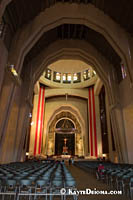 Above the museum is the Basilica. You can go back outside at this level to admire the 60 foot Corinthian columns close up and enjoy the view. This is the highest point you can climb if you’re ascending the 283 stars up the front of the Oratory. The interior dome rises 195 feet (60 m) above the floor. The cavernous space holds 2200 people seated in the metal folding chairs or 10,000 standing. It is rather stark in contrast to many basilicas in the world and less inviting than the cozy Crypt below. The dome is the third largest in the world after St. Peter’s in Rome and an African tribute to St. Peter’s, the Basilica of Our Lady of Peace in Ivory Coast. The stained glass windows depict some of the miraculous events in Canadian history attributed to the intervention of St. Joseph. The Grand Organ at the back of the Basilica has 5,811 pipes, with the longest 32 feet (9.75 m) tall. Organ recitals are every Sunday at 3:30 all year with a series of guest performances on Wednesday evenings in the summer.
Above the museum is the Basilica. You can go back outside at this level to admire the 60 foot Corinthian columns close up and enjoy the view. This is the highest point you can climb if you’re ascending the 283 stars up the front of the Oratory. The interior dome rises 195 feet (60 m) above the floor. The cavernous space holds 2200 people seated in the metal folding chairs or 10,000 standing. It is rather stark in contrast to many basilicas in the world and less inviting than the cozy Crypt below. The dome is the third largest in the world after St. Peter’s in Rome and an African tribute to St. Peter’s, the Basilica of Our Lady of Peace in Ivory Coast. The stained glass windows depict some of the miraculous events in Canadian history attributed to the intervention of St. Joseph. The Grand Organ at the back of the Basilica has 5,811 pipes, with the longest 32 feet (9.75 m) tall. Organ recitals are every Sunday at 3:30 all year with a series of guest performances on Wednesday evenings in the summer.
The Original Chapel built by Brother André in 1904 sits across a back parking lot to the right of the Oratory. The chapel was initially just the 15 by 18 feet that now make up the sanctuary. In 1910, the chapel was enlarged and a room was added on top which became Brother André’s living quarters. Although the building was damaged by fire in 1951, it was restored to its original condition. Brother Andre’s simple room has been kept as he left it.
The building that houses the Gift Shop also contains a snack bar and cafeteria, but at this writing they are closed temporarily for repairs. At the back of this building is the Carillon containing 56 bells that were designed for the Eiffel Tower but never installed there. Fifteen minute Carillon recitals are scheduled Thursdays and Fridays at noon and 3 pm and Weekends at noon and 2:30 pm.
I had originally planned to spend about an hour exploring this shrine, but I spent two and could have used another hour to see everything.
Saint-Joseph’s Oratory
3800, Chemin Queen Mary
Montreal ( Quebec) Canada
H3V 1H6
Phone: (514) 733-8211
Toll Free: 1-877-672-8647 x2795
Metro: Blue line, Cote-des-Neige station
Buses: 165 and 166
Website: www.saint-joseph.org
Printable Map
Hours and Additional Information
